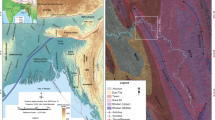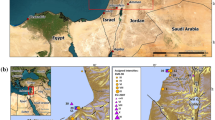Abstract
This study focuses on the initial subsidence mechanism of Korea Plateau in the East Sea. New interpretation of digitized multichannel seismic profiles (vertically unexaggerated) in the southern part of the South Korea Plateau delineates that acoustic basement comprises a number of normal-fault blocks, forming intra-plateau basins and troughs. In the western part of the plateau, the normal faults are oblique to the continental margin, whereas in the eastern part, they are bounded by an orthogonal transfer fault. The entire faults are suggestive of a large-scale dextral strike-slip fault system. The dextral fault system in the plateau was accompanied by a regional strike-slip fault along the North Korean continental margin, which offsets the prominent NE-SW granite belts on land and under the sea. The regional dextral strike-slip fault system activated during the late Oligocene/early Miocene to middle Miocene. The regional dextral strike-slip along the western continental margin of the sea was coupled with the complex dextral fault on the eastern margin from Sakhalin to Honshu. The regional strike-slip deformation was due to the changes in plate motion, i.e., southward drift (late Oligocene/early Miocene) and clockwise rotation (middle Miocene) of the Japanese Arc away from the Eurasian Plate.
Similar content being viewed by others
References
Amante, C. and Eakins, B.W., 2009, ETOPO1 1 arc-minute global relief model: procedures, data sources and analysis. NOAA Technical Memorandum NESDIS NGDC-24, National Geophysical Data Center, NOAA. DOI 10.7289/V5C8276M
Chwae, U.C., Kim, K.B., Hong, S.H., Lee, B.J., Hwang, J.H., Park, K.H., Hwang, S.K., Choi, P.Y., Song, K.Y., and Jin, M.S., 1995, Geological Map of Korea (1:1,000,000). Korea Institute of Geology, Mining and Materials, Daejeon, South Korea.
Cheong, C.S. and Kim, N.H., 2012, Review of radiometric ages for Phanerozoic granitoids in southern Korean Peninsula. Journal of the Petrological Society of Korea, 21, 173–192. (in Korean with English abstract)
Cho, D.R. and Kwon, S.T., 1994, Hornblende geobarometry of the Mesozoic granitoids in South Korea and the evolution of the crustal thickness. Journal of Geological Society of Korea, 30, 41–61. (in Korean with English abstract)
Cho, M., Kim, H., Lee, Y., Horie, K., and Hidaka, H., 2008, The oldest (ca. 2.51 Ga) rock in South Korea: U-Pb zircon age of a tonalitic migmatite, Daeijak Island, western Gyeonggi massif. Geosciences Journal, 12, 1–6.
Cho, M., Kim, T., Yang, S.-Y., and Yi, K., 2017, Paleoproterozoic to Triassic crustal evolution of the Gyeonggi Massif, Korea: tectonic correlation with the North China Craton. In: Law, R.D., Thigpen, J.R., Mersehat, A.J., and Stowell, H. (eds.), Linkages and Feedbacks in Orogenic Systems. Geological Society of America Memoir, 213. https://doi.org/10.1130/2017.1213(09)
Cho, M., Kwon, S.T., Ree, J.H., and Nakamura, E., 1995, High-pressure amphibolite of the Imjingang belt in the Yeoncheon-Cheongok area. Journal of Petrological Society of Korea, 4, 1–19. (In Korean with English abstract)
Chough, S.K. and Barg, E., 1987, Tectonic history of Ulleung basin margin, East Sea (Sea of Japan). Geology, 15, 45–48.
Chough, S.K. and Sohn, Y.K., 2010, Tectonic and sedimentary evolution of a Cretaceous continental arc-backarc system in the Korean peninsula: new view. Earth-Science Reviews, 101, 225–249.
Chough, S.K., 2013, Geology and Sedimentology of the Korean Peninsula. Elsevier, Amsterdam, 363 p.
Chough, S.K., Lee, D.J., and Ree, J.H., 2013, Whereabouts of the collision belt between the Sino-Korean and South China blocks in the northeast Asian margin. Geosciences Journal, 17, 397–401.
Harding, T.P., 1974, Petroleum traps associated with wrench faults. American Association of Petroleum Geologists Bulletin, 58, 1290–1304.
Honza, E., 1978, Geological investigations in the northern margin of the Okinawa Trough and the western margin of the Japan Sea, April–May 1977 (GH 77-2 cruise). Cruise Report No. 10, Geological Survey of Japan, Kawasaki, 79 p.
Jolivet, L. and Tamaki, K., 1992, Neogene kinematics in the Japan Sea region and volcanic activity of the northeast Japan arc. In: Tamaki, K., Suyehiro, K., Allen, J., McWilliams, M. et al. (eds.), Proceedings of the Ocean Drilling Program, Scientific Results, Volume 127/128 (Part 2). College Station, TX (Ocean Drilling Program), p. 1311–1331.
Jolivet, L., Tamaki, K., and Fournier, M., 1994, Japan Sea, opening history and mechanism: a synthesis. Journal of Geophysical Research, 99, 22,237–22,259.
Kaneoka, I., Takigami, Y., Takaoka, N., Yamashita, S., and Tamaki, K., 1992, 40Ar-39Ar analysis of volcanic rocks recovered from the Japan Sea floor: constraints on the age of formation of the Japan Sea. In: Tamaki, K., Suyehiro, K., Allen, J., McWilliams, M. et al. (eds.), Proceedings of the Ocean Drilling Program, Scientific Results, Volume 127/128 (Part 2). College Station, TX (Ocean Drilling Program), p. 819–836.
Kim, G.B., Yoon, S.H., Chough, S.K., Kwon, Y.K., and Ryu, B.J., 2011, Seismic reflection study of acoustic basement in the South Korea Plateau, the Ulleung Interplain Gap, and the northern Ulleung Basin: volcano-tectonic implications for Tertiary back-arc evolution in the southern East Sea. Tectonophysics, 504, 43–56.
Kim, G.B., Yoon, S.H., Sohn, Y.K., and Kwon, Y.K., 2013, Wave-planation surfaces in the midwestern East Sea (Sea of Japan): indicators of subsidence history and paleogeographic evolution of back-arc basin. Marine Geology, 344, 65–81.
Kim, H.J., Han, S.J., Lee, G.H., and Huh, S., 1998, Seismic study of the Ulleung Basin crust and its implications for the opening of the East Sea (Japan Sea). Marine Geophysical Research, 20, 219–237.
Kim, H.J., Jou, H.T., Cho, H.M., Bijwaard, H., Sato, K., Hong, J.K., and Baag, C.E., 2003, Crustal structure of the continental margin of Korea in the East Sea (Japan Sea): evidence for rifting affected by the hotter than normal mantle. Tectonophysics, 364, 25–42.
Kim, H.J., Lee, G.H., Choi, D.L., Jou, H.T., Li, Z., Zheng, Y., Kim, G.-Y., Lee, S.H., and Kwon, Y.K., 2015, Back-arc rifting in the Korea Plateau in the East Sea (Japan Sea) and the separation of the southwestern Japan Arc from the Korean margin. Tectonophysics, 638, 147–157.
Kim, H.J., Lee, G.H., Jou, H.T., Cho, H.M., Yoo, H.S., Park, G.T., and Kim, J.S., 2007a, Evolution of the eastern margin of Korea: constraints on the opening of the East Sea (Japan Sea). Tectonophysics, 436, 37–55.
Kim, J.K., Woo, K.S., Yoon, S.H., and Suk, B.C., 2007b, Sedimentary characters of the core sediments and their stratigraphy using 87Sr/86Sr ratio in the Korea Plateau, East Sea. Journal of the Korean Society of Oceanography, 12, 328–336. (in Korean with English abstract)
Kimura, G. and Tamaki, K., 1986, Collision, rotation, and back-arc spreading in the case of the Okhotsk and Japan Seas. Tectonics, 5, 389–401.
Kwon, S.T., Ree, J.H., Park, K.H., and Jeon, E.Y., 1995, Nature of contact between the Ogcheon belt and Yeongnam massif and the Pb-Pb age of granitic gneiss in Cheondong-ri, Danyang. Journal of the Petrological Society of Korea, 4, 144–152. (in Korean with English abstract)
Kwon, Y.K., Yoon, S.H., and Chough, S.K., 2009, Seismic stratigraphy of the western South Korea Plateau, East Sea: implications for tectonic history and sequence development during back-arc evolution. Geo-Marine Letters, 29, 181–189.
Lallemand, S. and Jolivet, L., 1985/86, Japan Sea: a pull-apart basin? Earth and Planetary Science Letters, 76, 375–389.
Lee, J.I., Hur, S.D., Huh, S., Chun, J.H., and Han, S.J., 2000, Geochemistry and Sr-Nd isotopic composition of granites sampled from the Korea Plateau, East Sea. Journal of the Geological Society of Korea, 36, 279–294. (in Korean with English abstract)
Lee, S.R. and Cho, K.O., 2012, Precambrian crustal evolution of the Korean Peninsula. Journal of the Petrological Society of Korea, 21, 89–112. (in Korean with English abstract)
Lee, S.R., Cho, D-L., and Wu, F-Y., 2016, Contrasting source domains for the Phanerozoic granitoids in South Korea revealed by zircon Hf isotopic signatures. Geosciences Journal, 20, 585–596.
Lee, Y., Cho, M., Cheong, W., and Yi, K., 2014, A massif-type (1.86 Ga) anothosite complex in the Yeongnam Massif, Korea: late orogenic emplacement associated with the mantle delamination in the North China Craton. Terra Nova, 26, 408–416.
Min, K.K., Cho, M., and Reiners, P.W., 2008, Exhumation history of the Taebaek mountain range in Korean Peninsula: implications for Miocene tectonic evolution of East Asia. AGU Fall Meeting Abstracts, San Francisco, Dec. 15–19, T53B-1922.
Ree, J.H., Cho, M., Kwon, S.T., and Nakamura, E., 1996, Possible eastward extension of Chinese collision belt in South Korea: the Imjingang belt. Geology, 24, 1071–1074.
Sagong, H., Kwon, S.T., Jeon, E.Y., and Mertzman, S.A., 1997, Geochemistry and petrology of the Hwacheon granite. Journal of Geological Society of Korea, 33, 99–110. (in Korean with English abstract)
Sato, T., Sato, T., Shinohara, M., Hino, R., Nishino, M., and Kanazawa, T., 2006, P-wave velocity structure of the margin of the southeastern Tsushima Basin in the Japan Sea using ocean bottom seismometers and airguns. Tectonophysics, 412, 159–171.
Sylvester, A.G., 1988, Strike-slip faults. Geological Society of America Bulletin, 100, 1666–1703.
Tamaki, K., 1988, Geological structure of the Japan Sea and its tectonic implications. Bulletin of the Geological Survey of Japan, 39, 269–365.
Yoon, S.H. and Chough, S.K., 1995, Regional strike slip in the eastern continental margin of Korea and its tectonic implications for the evolution of Ulleung Basin, East Sea (Sea of Japan). Geological Society of America Bulletin, 107, 83–97.
Yoon, S.H., Sohn, Y.K., and Chough, S.K., 2014, Tectonic, sedimentary, and volcanic evolution of a back-arc basin in the East Sea (Sea of Japan). Marine Geology, 352, 70–88.
Author information
Authors and Affiliations
Corresponding author
Rights and permissions
About this article
Cite this article
Chough, S.K., Shinn, Y.J. & Yoon, S.H. Regional strike-slip and initial subsidence of Korea Plateau, East Sea: tectonic implications for the opening of back-arc basins. Geosci J 22, 533–547 (2018). https://doi.org/10.1007/s12303-018-0017-0
Received:
Accepted:
Published:
Issue Date:
DOI: https://doi.org/10.1007/s12303-018-0017-0




